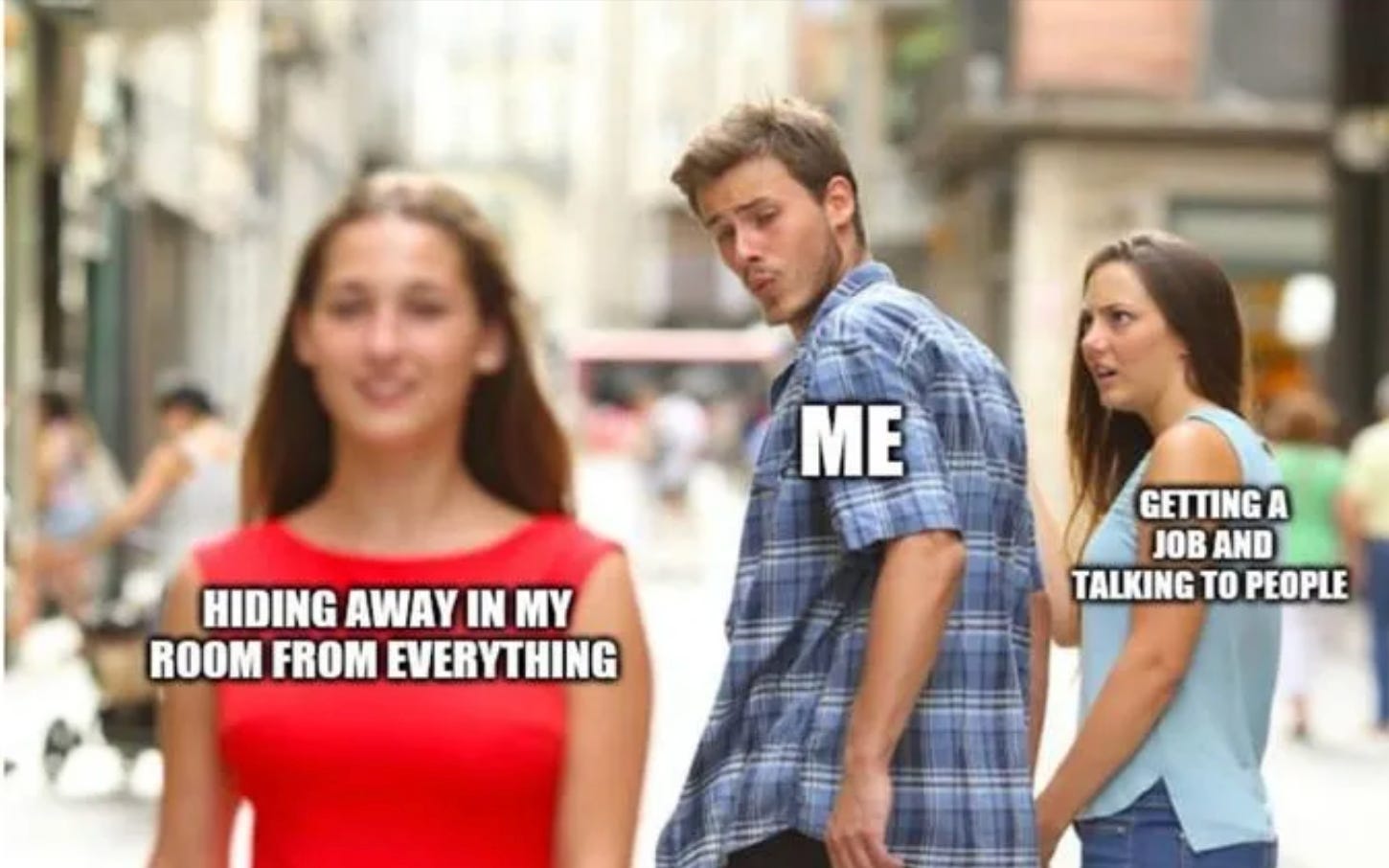This post exists to explain an idea I apply everywhere but haven’t comprehensively described anywhere. It grows from my Master’s thesis, which was focused on Distracted Boyfriend, a 2017 meme based off a stock photograph from 2015. It has since become one of those memes that sticks around, a standard expression in the online-cultural lexicon. You’ve likely seen it before.
My reasons for choosing Distracted Boyfriend were about fifty percent practical: I wanted to do a meme case study and DBF is one of the best-known memes. It’s also a meme which is obviously about gender to some degree, meaning the historians and literary scholars I was writing for would find it legible as a “text” commenting on society. And few memes are as clearly rhetorical as this one. DBF is all about making value judgments and performing an act of choosing — which, again, I thought would make a study of it more legible to a non-meme-enjoying audience. I covered both those topics (gender and rhetoric in DBF) in my thesis and in previous posts on this newsletter,
but this post is about surveillance.
The other fifty percent of my reasoning was Distracted Boyfriend’s emphasis on gaze. It’s a picture of a person (the girlfriend) looking at a person (the boyfriend) who’s looking at another person (the woman in red). You, as the viewer, are looking at them all and the stranger who put words on top of them. And then the algorithm is looking at you.
Surveillance is a central theme in studies of the internet, as it is in studies of contemporary history and power (salut, Michel Foucault). And, when you think about surveillance, it is really two motions: the looking/recording, and then the documenting. The two motions feed one another because you document what you see and, as a surveiller, you look at the world in order to find something you can document. What perhaps separates surveillance from just a normal gaze is the motive of documentation.
If surveillance involves watching and then documenting, it is at heart a process about interacting with some kind of text. Looking at texts helps you understand power in general, because types of media scaffold patterns of thought and social interaction — this is one way “the medium is the message.” For example:
The charismatic star performs a song in front of the mass, is the singular focus of attention, and gets called the “king of pop.” Or the writer lays out her argument to be rationally judged by the jury of unseen readers. Or the podcaster confides an unconventional “truth” in the ear of the initiated listener. These are all, to my thinking, politically charged encounters — even when the content made in these different forms is not partisan. Media implicitly make scenes of authority, and political power stages itself across these same scenes.
So, what type of authority do memes invoke? Surveillance.
Memes aestheticize digital surveillance. If memes are all about “we are watching and judging him,” or “I am looking at her and you are with me against her” (as we are quite clearly doing in Distracted Boyfriend) then that mirrors what the platforms do, which is primarily surveil and judge users. Memes take the acts of surveillance and turn them into a mode of reading for pleasure and reaching out to others. In other memes, this motion is less apparent than it is in Distracted Boyfriend, but I would argue it is still there. I chose Distracted Boyfriend because of how visible it makes those dynamics of
surveillance as a cultural form.
In Michel Foucault’s work, he draws a connection between surveillance and types of “grids” which the surveiller creates to sort social reality into. Certain signifiers — whether bodies, utterances, or objects — are coded into particular categories. We find the sick and the well, the true and the false — and forms of surveillance are developed to sort social reality into these buckets, and in so doing act upon it.
It is downstream of surveillance that much of our identity is formed: the straight-A student is smart because they have been surveilled as such, just as the addict is sick because she has been diagnosed, and the migrant is an alien because the court has declared him so. This is not to say a kid wouldn’t be smart, a person wouldn’t be sick, or a migrant wouldn’t be persecuted if such categories didn’t exist — just that the types of definition, and the resulting treatment of that person by society, flow from the category generated through the process of institutional surveillance.
This process is never set in stone: it evolves alongside politics, science, public opinion, and technology. Foucault’s proposition in his later work, as I understand it, is that the action of surveilling living bodies is the basis of modern power within human societies. In the past, the power to end life — to execute, often in public spectacles — was the basis of power.
Institutional surveillance in the 19th and 20th centuries, despite its genealogical connection to what Google and Meta do now, is very different from the type of surveillance we see on social media. Shoshanna Zuboff’s notion of surveillance capitalism is not really Foucauldian. But I think we do see a few similarities. There’s that mutual feedback loop of documenting what you see, and looking in order to document (this is what the algorithm does). Then there’s that determination of social/economic outcomes based on surveillance: some people’s posts do numbers, others don’t. And, more hazily, there is the use of surveillance as a technique of essentially political control.
But my interest here is more so in the process than in the result. I am interested in how memes allow us to look and to document, to creatively and constructively surveil one another. And my argument is that by doing so, memes illustrate what that process (which is constantly being done to us as well as by us) feels like.
Adding labels to a Distracted Boyfriend meme means classifying bodies: he is literally labelled as one thing, she as another, and a relation is implied which, generally, is rooted beyond what the image itself suggests. Posting a meme like this is a performance of a surveilling act, saying “I have looked at this image and categorized the bodies within it.” The platform interface itself then invites the viewer to classify the resulting meme: is it worthy of a like?
I do not mean to say this is the only process happening in the reception of memes, but it is one of the most important. And I think in the interface and everyday usage of computers themselves you find
the concrete forms behind aestheticized surveillance.
Here is what I mean. Look at this quote-tweet:
Here we have five primary speakers, who I will describe chronologically. The first and lowest-down in the frame is the embedded Instagram caption by Pastor Troy, a rapper looking at Lil Nas X on television and attacking his queerness. The second speaker, Ronald Isley, is a musician reading Pastor Troy’s post and judging/describing it as “a long homophobic rant.” The third speaker is Lil Nas X, reading both Isley’s reframing of Pastor Troy’s post and the original post itself — he adds “I look good in that pic on god.”
The fourth speaker doesn’t say words, but expresses itself in numbers: that’s the audience. Over 600,000 people have, through a like, signed onto Lil Nas X’s view of the situation. The importance of this type of participation is seen in online culture’s obsession with “ratios” — when a reply or quote post dissenting with the piece of content it responds to garners more likes and therefore legitimacy than the original piece of content.
The fifth speaker also doesn’t say words and has a different set of motives for interacting than the others. That’s the algorithm, the platform, the website itself which, when this post was encountered in situ, served it to me. This fifth speaker was also responding to the other speakers — mostly, the fourth speaker (the mass of likes). And it, in turn, is being spoken to by everyone interacting with the post, since they are all seeking visibility from the platform/algorithm.
Arguably, each of these speakers not only surveils the others, but publicly performs their surveillance. What we’re seeing is people reading, watching, and judging other people — so that they may be judged, watched, and read themselves. The username of Lil Nas X, “i am reading all that,” is most proximately a reference to a meme, but it also suggests that one of his main roles as a poster is to be a reader of other people.
Back to Distracted Boyfriend now.
The layers are most visible in a quote-tweet, where they are explicitly shown as windows embedded within other windows (or, if you want to get really technical with it, <div> within <div>).
But the gazes in the Distracted Boyfriend image offer a similar structure. Here is my rough illustration of what that may look like, in situ:
Although the emotional valences are different, as an audience member confronting this meme we are doing something analogous to when we look at the quote-tweet. We are looking at the meme maker looking at the girlfriend looking at the boyfriend looking at the woman in red — in the same way that, when viewing the quote tweet, we’re looking at 600,000 supporters looking at Lil Nas X looking at Ronald Isley looking at Pastor Troy looking at Lil Nas X. It feels weird to write the word “looking” this many times.
Combined with all the lookings are a series of performed responses. The boyfriend is visibly impressed by the woman in red’s butt. The girlfriend is aghast at his response. A few dozen people have liked the post. The algorithm has decided you might like it too.
One way to see this layered structure is as a sediment of traces left by different screens. Each layer is a slice taken from another person’s screen and sandwiched between the screens of others. At the bottom-most layer is the screen of the photographer, Antonio Guillem in 2015. Then there’s the meme-maker’s screen in 2017, the screens of subsequent meme makers who saw and copy-pasted that 2017 meme as a .png or whatever os they could make their own version. And now there’s your screen. And the action we perform across our screens? Surveillance.
There is a temporality and pragmatics to this. The deepest screen is the earliest, and the shallowest is the most recent. The speakers further-up and more recent get to manipulate and reframe what the previous people have said. You, the viewer — at the shallowest point of the post — have the apparent capacity to do whatever you want with it, according to the menu of interaction options the platform offers.
There is also a from of double-edged meta-surveillance happening when users meet the algorithm. On the one hand, the documentation/categorization provided by users becomes evidence for the algorithm to look at. On the other hand, the algorithm’s documentation/categorization becomes an ongoing spectacle for people to surveil. It often happens that when something goes viral, the heart of the story is “why and how is this the thing that’s gone viral?” (cf. Tuah, Hawk 2024.) We are surveilling social media and performing a certain attitude towards it. Every meme ends up being about the internet itself in this sense. Every meme is about looking at other people’s looking.

Anyhoo, now that we’ve arrived at Hawk Tuah, I’m gonna go to bed.










i feel weird perceiving this
I’ve only recently began using Substack regularly, but I just know that this is one of those articles I will keep coming back to. Such a brilliant analysis !